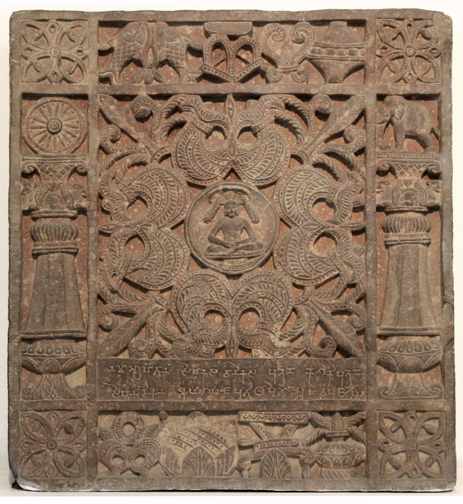
Mathura, India
This ayagapata named so after the donor has as the central image a Jina seated in a meditative posture on an elevated platform. A parasol embellished with garlands framing the Jina’s head and shoulders indicates his venerable status. Surrounding the Jina in four cardinal directions are four three-pronged ω -shaped forms known as nandyavartas (indicating the three jewels of Jain practice: right faith, right knowledge and right conduct). The bottom and top registers carry symbols including a pair of fish, an unending knot (shrivatsa), a pitcher, an auspicious seat, and an overflowing pot, that eventually developed into a set of eight auspicious symbols signifying good fortune and prosperity.
Sihanāṃdikā Āyāgapaṭa
- Red sandstone
Mathura, India
This ayagapata named so after the donor has as the central image a Jina seated in a meditative posture on an elevated platform. A parasol embellished with garlands framing the Jina’s head and shoulders indicates his venerable status. Surrounding the Jina in four cardinal directions are four three-pronged ω -shaped forms known as nandyavartas (indicating the three jewels of Jain practice: right faith, right knowledge and right conduct). The bottom and top registers carry symbols including a pair of fish, an unending knot (shrivatsa), a pitcher, an auspicious seat, and an overflowing pot, that eventually developed into a set of eight auspicious symbols signifying good fortune and prosperity.
- Created: Mid-1st century
- Attribution: Credit: National Museum, New Delhi (J.249). Photo: Sonya Rhie Mace